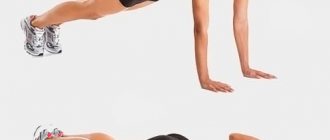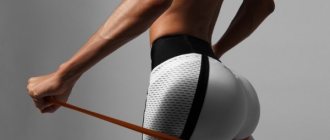In bodybuilding and fitness, the deltoid muscles occupy a special position. Despite the fact that the muscle area belongs to small groups, in terms of frequency of training it is second only to the biceps. The reason is not only the importance of the deltoid muscles in anatomy, but also to enhance the aesthetics of the figure. Understanding the functions and characteristics of the delta bundles allows you to maximize the effectiveness of the training process and significantly reduce the risk of injury.
Structure and functions
The deltoid muscle of the shoulder consists of three heads (bundles):
- Anterior or lateral (clavicular) – starts from the lateral part of the clavicle;
- Middle or acromial - starts from the acromial part of the scapula;
- Posterior or spinous - starts from the lower edge of the scapula bone.
Despite the fact that each head originates in different places, they are all attached by a common tendon to the deltoid (or V-shaped) tuberosity of the humerus. The delta muscles have a triangular shape, from which the group gets its name (the Greek letter “delta”).
Deltoid muscle structure photo
The functions of the deltoid muscles are considered, with specification of each bundle.
Front:
- lateral abduction of the arm during external rotation of the shoulder;
- shoulder internal rotation;
- shoulder antiversion (with the arm abducted);
- help the pectoral muscle flex the shoulder.
Average:
- abduction of the shoulder to the side (with the arm abducted).
Rear:
- shoulder extension;
- shoulder adduction (with the arm adducted);
- shoulder external rotation;
- abduction and retroversion of the shoulder (with the arm abducted).
In sports, a more simplified definition of functions is used. They are divided depending on where the head of the deltoid muscle is located. This division has some exceptions, but is generally suitable for understanding the functions of each head for athletes without specialized training.
- Forward (in front of) movements primarily engage the anterior head.
- Movements to the sides - medium.
Pulling the arm back in a raised position engages the posterior deltoid muscle.
Deltoid
The deltoid is a large, superficial muscle that covers the outer contour of the shoulder. The muscle originates from most of the anterior edge and upper surface of the lateral third of the clavicle, from the acromial part of the scapula from the lower part of the posterior edge of the spine of the scapula along its entire length to the medial edge. It begins where the trapezius muscle ends, but is clearly separated from it by a bony landmark. The thick fibers of the deltoid muscle converge at one point and pass into a common tendon that attaches to the V-shaped tuberosity (deltoid tuberosity, tuberositas deltoidea) on the outer surface of the humerus. The muscle is called deltoid because of the triangular shape it forms (Greek letter Δ (delta)).
The deltoid is the primary muscle that is involved in almost all movements of the shoulder. Its feathery fiber structure, large cross-sectional area, and wide attachment area create excellent leverage in the shoulder joint. The deltoid muscle also plays an important role in stabilizing the shoulder joint. When all bundles of the deltoid muscle contract simultaneously, abduction of the arm occurs in the frontal plane. The supraspinatus muscle stabilizes the head of the humerus, while the deltoid muscle abducts the shoulder and prevents the head of the humerus from impinging on the humeral process. This tandem provides smooth and powerful shoulder movement.
The anterior deltoids work in conjunction with the pectoralis major muscles to flex the shoulder. They help the muscles: subclavian, pectoralis major and latissimus dorsi with internal rotation of the shoulder. As a result of this association with the pectoralis major muscle, as well as the fact that most daily activities load the anterior deltas, it is much better developed than the posterior one.
The lateral bundles participate in the lateral abduction of the shoulder when it is in internal rotation and in the horizontal abduction when it is in external rotation, but practically do not participate in the horizontal extension of the shoulder (when it is in internal rotation).
The posterior bundles take a large part in horizontal extension, especially due to the small participation of the latissimus dorsi muscle in this movement in the horizontal plane. Other horizontal extensors—the infraspinatus and teres minor—also work with the posterior deltoid as external rotators, antagonistic to the internal rotators—the pectoralis major and latissimus. The posterior portion of the deltoid muscle also takes a large part in hyperextension of the shoulder, with the support of the long head of the triceps
DELTOID
- Beginning: Lateral third of the clavicle, acromial part of the scapula, lower part of the posterior edge of the spine of the scapula.
- Insertion: Deltoid tuberosity of humerus
Functions
- Arm abduction in the frontal plane (all beams)
- Lateral abduction with shoulder external rotation, shoulder flexion, internal rotation (anterior fascicles)
- In the lateral abduction of the shoulder when it is in internal rotation and in the horizontal abduction when it is in external rotation (lateral fibers)
- Horizontal extension (posterior fascicles)
Blood supply: posterior circumflex artery of the shoulder (a.circumflexa humeri posterior).
Innervation: Axillary nerve C5–6
Deltoid muscle - Palpation
Patient: sitting, shoulder abducted 30 degrees. Execution: pinch palpation is performed across moderately tense fibers to identify painful muscle compactions in the thickness of the muscle. Accordingly, tenderness is detected on palpation of the anterior deltoid muscle in the anterior edge of the muscle in front of the shoulder joint. When palpating the middle part of the muscle, it is directly below the brachial process and distal to the attachment of the supraspinatus tendon (the supraspinatus tendon often becomes painful with chronic tension of the muscle: when the shoulder is abducted 90°, the tendon attachment of the supraspinatus muscle is displaced under the brachial process and becomes inaccessible to palpation, while the affected anterior part of the deltoid muscle remains easily accessible for palpation of painful areas). When palpating the back of the muscle, along its posterior edge.
Homework for a client
- Sit with your back straight and looking forward.
- Slowly lean forward and grab the handle with both hands.
- Straighten your back, bend your elbows, and bring your shoulder blades together.
- Bend your arms gradually as you move
- Return to starting position, then repeat.
Top exercises for deltoids
All movements are divided into categories, depending on where the head of the deltoid muscle is located. Even basic exercises cannot load all three bundles evenly, so the work on each head is divided (even training on different days).
Basic exercises (using beams)
- Military press or barbell/dumbbell press in a standing or seated position (middle, front).
- Seated overhead press (middle, front).
- Barbell row to the chin or “pull” (middle, front).
- Lee Haney Deadlift (back, middle).
- Arnold press (front, middle).
Isolation exercises (taking into account the anatomy of the deltoid muscles of the shoulders)
- Raise a dumbbell in front of you - front bun.
- Raise your arm in front of you in the lower block of the crossover - front.
- Hand abduction to the side – average.
- Bent-over dumbbell raises – rear.
- Dumbbell row in a lying position with support (with elbows pointed to the sides) - back.
- Reverse spreads in Peck-Deck – rear.
All other exercises are duplicates. That is, when the conditions for performing a movement change, the load on specific delta beams does not change in any way. For example, abducting the arm to the side in a bend over with a dumbbell and a lower block.
Exercises to develop the deltoid muscle
An important exercise for this muscle group is the bench press. Like any other exercise, the bench press is performed in several approaches, achieving maximum tension and a second delay at this point to better work out the deltoid muscle.
- Number of approaches - 4 times
- Number of repetitions - 8 - 12 times
- Weight - individually, but so that it is smooth and without jerking
Dumbbell delt press
The dumbbells are positioned at shoulder level, palms forward and elbows pointing out to the sides. The dumbbells are raised up, then lowered as low as possible. The exercise is aimed at developing the front part of the deltoid muscles.
Dumbbell bent over deltoid press
Leaning forward, bring the dumbbells together at knee level, palms of your hands facing each other. While lifting the dumbbells straight to the sides, while turning your wrists to the sides, keep your body motionless. Raise the dumbbells slightly above your shoulders, then slowly return to the starting position. Training isolated posterior heads of the deltoid muscle.
Regularly perform the exercises listed above, achieving maximum tension in the deltoid muscles. You will certainly notice an improvement in your terrain. Health and beauty to you!
Delt training
Many beginners make the mistake of thinking that arm and chest training should take up the lion's share of training. But, believe me, narrow shoulders in combination with massive arms and a pumped chest will not look harmonious. Therefore, delta training must be included in the set of exercises.
Proper training
According to practice, the most optimal option for training deltas will be in the range from 7 to 12 repetitions in one set. This method is one of the most effective for rapid weight gain in almost all muscle groups. In addition, the deltoid muscles must be subjected to significant loads, almost to the limit of their capabilities, for their stable growth.
Many videos about training deltas and various articles say that this muscle consists of bundles: anterior, medial, and posterior. This feature of the muscle structure must be taken into account when creating an individual workout. Indeed, in addition to general exercises, it is also necessary to do isolated ones, which are aimed at working out each individual beam.
Set of exercises
One of the effective exercises for training deltas is dumbbell swings. They are best done in the range of 15 to 20 repetitions. But the deltoid muscles are also easily injured due to their complex anatomical structure.
The shoulders are included in the work in almost all complexes that are designed to pump up the upper body. So before you put a significant load on your shoulders, you need to warm them up thoroughly. You've probably already heard about this in various videos about training deltas.
The majority of bench press exercises for training deltoids for mass are best done in a Smith machine. Due to the fact that the bar in this simulator moves only in one plane, stabilizer muscles can be excluded from the work. In this case, the deltas will receive the maximum possible load.
Training deltas for mass may look like this:
- Smith machine press 3x12
- Dumbbell overhead press 3x12
- Standing dumbbell swings 3x12
- Seated weight press 3x10
Experienced bodybuilders need to include at least two basic and two or three isolation exercises in their deltoids training program. Each set should consist of eight to ten repetitions, this number is optimal for effective muscle growth.
According to bodybuilding professionals, the best ways to train your deltoids are the military press and the standing barbell press. They are aimed at intensive training of all delta beams, except the back one.
If you pay attention to the video of deltoids training for mass, you will notice that many athletes do Arnold presses and standing barbell rows to the chin. In these exercises, the middle (medial) delta bundle is used to a greater extent, which is responsible for the formation of massive shoulders
Advice!
However, it is worth understanding that the muscles little by little begin to get used to the same exercises, so they should be changed periodically. This will allow you not to slow down while gaining weight.
Most isolation exercises, such as dumbbell overhead presses (you can also use a barbell), barbell raises, and dumbbell rows while lying on your stomach, use the anterior and posterior deltoids. And this is due to the fact that basic exercises act on the medial muscle bundle at sufficient intensity.
There are still many complexes that can significantly develop the shoulders, but they are essentially duplicative and less effective. The exercises described above are quite enough to form developed and sculpted shoulders.









